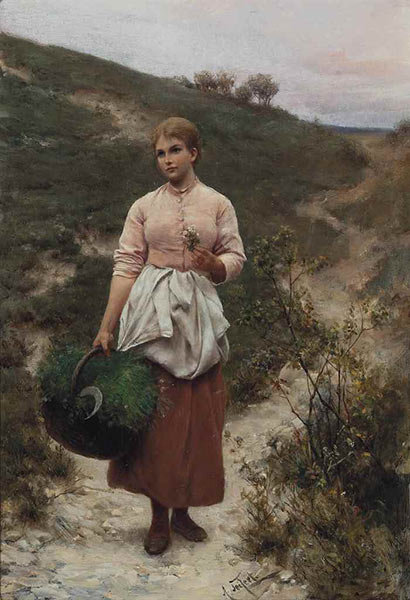In this ongoing series for Fine Art Today, we take a longer look at the history and features of a soon-to-be-available artwork of note. This week: Alfred Seifert, “Picking Flowers.”
Personal misfortune ultimately helped steer Czech-German painter Alfred Seifert (1850-1901) toward art, and the world is better off for it. Born in Praskolesy, present-day Czech Republic, in 1805, Seifert experienced a serious illness as a child that left him unable to walk for four years. Spending most of his time in bed, Seifert took up drawing to entertain himself, and he — and his caretakers — quickly noticed that he had considerable artistic talent. After high school, Seifert was accepted into the Academy of Fine Arts in Munich, Germany, in 1869, and there the young painter developed an affinity for female portraiture.
Catering to the German market, Seifert achieved success for his “Seifert types” — often gorgeous female sitters with romantic expressions in lush outdoor settings. Although his connection to the Pre-Raphaelite Brotherhood is vague at best, Seifert’s penchant for female portraiture and pure traditional style situates him well within the range of popular tastes of his generation. In Germany, critics greatly appreciated the painter’s acute observational skill, well-thought-out compositional strategies, harmony of color, and pastoral atmosphere.
Leading all lots during Christie’s January 20 “19th Century European Art” sale is a beautiful Seifert oil, titled “Picking Flowers.” Of course, the work is unmistakably a “Seifert type,” with a single female subject who faces toward the viewer. Dressed in contemporary rural clothing of the era, the subject holds a woven basket that bursts with a large bundle of wildflowers. Although her gaze does not meet ours, she presents the viewer with a small bouquet, held in her left hand. The simple gesture is a warm and welcoming one, beckoning the viewer into the piece. Further, she stands in the foreground along a well-trodden path, which winds its way into the background. The palette of the piece is muted in tone, but beautifully arranged and balanced. The red in the subject’s dress is made more intense through complementary use of green in the bundle of flowers.
The market for Seifert’s work appears relatively pedestrian today, with this piece expected to realize around $3,000. However, works by Seifert have commanded five-figure numbers as recently as 2008, with his “Flora” selling for $10,258.
To view the full catalogue, visit Christie’s.
This article was featured in Fine Art Today, a weekly e-newsletter from Fine Art Connoisseur magazine. To start receiving Fine Art Today for free, click here.
Featured Lot: Alfred Seifert, “Picking Flowers”








